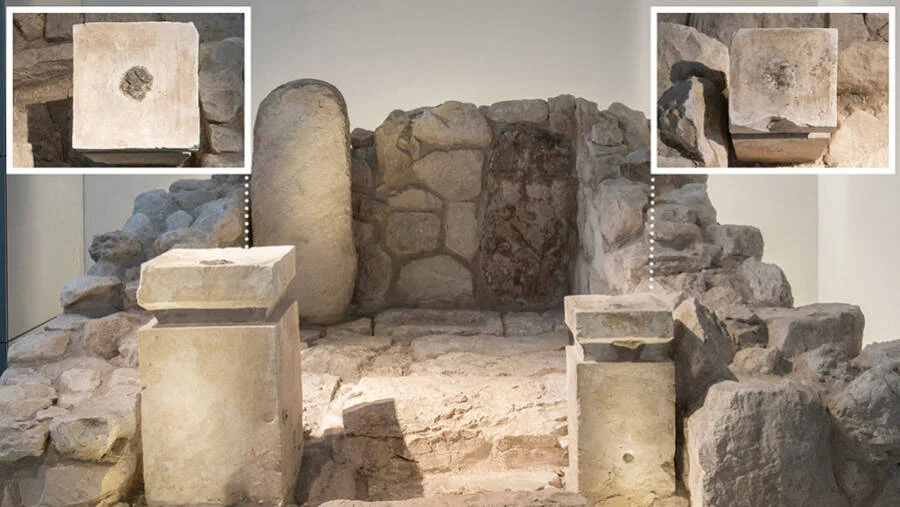Scientists have made a remarkable discovery at the Tel Arad shrine in Israel, unearthing the oldest known evidence of ritualistic cannabis burning. This groundbreaking find sheds new light on ancient religious practices and the significance of cannabis in the ancient world. The cannabis found on the limestone altar was mixed with animal dung to create a slower and more controlled burn, while frankincense was also discovered on another altar, contributing to the olfactory experience of the rituals performed at the shrine.
Tel Arad Shrine

The Tel Arad shrine, located in Israel, has been the subject of extensive archaeological excavations. The shrine consisted of two fortresses and a dedicated cult area, which likely served as a site for religious rites. Through modern analysis, researchers have now identified residues atop the altars, offering insight into the practices conducted within the shrine.
Historic Significance
Published in the Journal of the Institute of Archaeology of Tel Aviv University, the discovery marks the first identification of cannabis in the Ancient Near East. Lead author Eran Arie from the Israel Museum in Jerusalem emphasizes that cannabis played a central role in the cultic rituals performed at the shrine, indicating its cultural and religious significance during that time.
Cannabis and Animal Dung
The cannabis discovered on the altar was mixed with animal dung, allowing for a slower burn at lower temperatures. This mixture ensured that the cannabis would last for the duration of the religious rite. The deliberate combination of cannabis and animal dung reveals the meticulous preparation and attention to detail that went into the religious practices at the shrine.
Exploring the Tel Arad Shrine

The Tel Arad shrine is a complex structure consisting of an open courtyard, a main hall, and a small cella referred to as the “Holy of Holies.” The cella contained the necessary items for religious rituals and was considered the heart of the shrine. The shrine’s construction on an east-west axis suggests its potential ritualistic significance.
The Buried Shrine
The reasons behind the shrine’s burial remain unclear. It is speculated that the burial could have been a ritualistic act or a means of protecting it from the occupying Assyrians of that time. Recent examinations of the shrine’s stairs, floor, and furniture have revealed the presence of authentic incense, providing further evidence of the shrine’s religious purpose.
Chemical Analysis and Revelations

Chemical analysis of the dark residue discovered on the altars was initially inconclusive or undisclosed. However, modern techniques have now revealed the presence of cannabis and frankincense. The psychoactive properties of the cannabis were significant, as inhaling the fumes alone was enough to induce its effects. The combination of animal fat with frankincense allowed for a controlled and elevated burn.
Trade Routes and Cultural Exchange
The origin of cannabis in Tel Arad remains a subject of speculation. Archaeobotanist Robert Spengler suggests that early Silk Road trade routes from central and eastern Asia might have facilitated the introduction of cannabis to the region. This discovery highlights the extensive cultural exchange that took place along ancient trade routes.
Reassessing Ancient Cultic Practices
The inclusion of cannabis and frankincense in the religious rituals of Judah challenges previous understandings of cultic practices in the region. This finding indicates a broader use of hallucinogenic materials and ingredients to induce religious ecstasy, which was not previously associated with ancient Judahite practices.
New Perspectives and Future Research
The discovery of ancient cannabis residue on the altar of the Tel Arad shrine provides exciting new insights into ancient religious practices. It offers researchers a fresh perspective on the cultural, historical, and religious significance of cannabis in the ancient world. Further research will continue to unravel the mysteries surrounding ancient religious practices and deepen our understanding of this intriguing period in history.
Conclusion
The revelation of cannabis residue on the altar of the Tel Arad shrine in Israel has captivated researchers and archeologists alike. This groundbreaking discovery sheds light on the important role cannabis played in ancient religious practices, challenging previous beliefs and offering new perspectives on the cultural traditions of the time. As we continue to explore and analyze ancient sites, we uncover new facets of history that reshape our understanding of the past.



